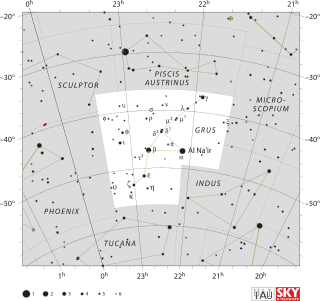
Grus is a constellation in the southern sky. Its name is Latin for the crane, a type of bird. It is one of twelve constellations conceived by Petrus Plancius from the observations of Pieter Dirkszoon Keyser and Frederick de Houtman. Grus first appeared on a 35-centimetre-diameter (14-inch) celestial globe published in 1598 in Amsterdam by Plancius and Jodocus Hondius and was depicted in Johann Bayer's star atlas Uranometria of 1603. French explorer and astronomer Nicolas-Louis de Lacaille gave Bayer designations to its stars in 1756, some of which had been previously considered part of the neighbouring constellation Piscis Austrinus. The constellations Grus, Pavo, Phoenix and Tucana are collectively known as the "Southern Birds".
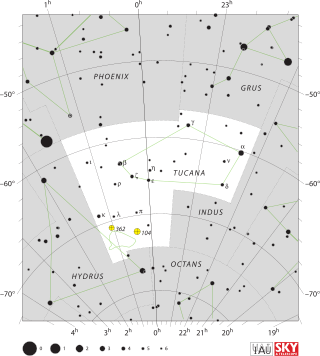
Tucana is a constellation of stars in the southern sky, named after the toucan, a South American bird. It is one of twelve constellations conceived in the late sixteenth century by Petrus Plancius from the observations of Pieter Dirkszoon Keyser and Frederick de Houtman. Tucana first appeared on a 35-centimetre-diameter (14 in) celestial globe published in 1598 in Amsterdam by Plancius and Jodocus Hondius and was depicted in Johann Bayer's star atlas Uranometria of 1603. French explorer and astronomer Nicolas Louis de Lacaille gave its stars Bayer designations in 1756. The constellations Tucana, Grus, Phoenix and Pavo are collectively known as the "Southern Birds".
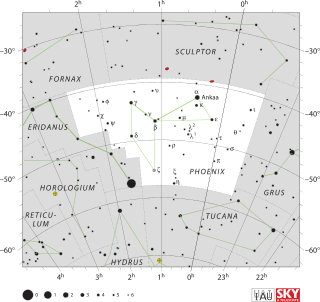
Phoenix is a minor constellation in the southern sky. Named after the mythical phoenix, it was first depicted on a celestial atlas by Johann Bayer in his 1603 Uranometria. The French explorer and astronomer Nicolas Louis de Lacaille charted the brighter stars and gave their Bayer designations in 1756. The constellation stretches from roughly −39° to −57° declination, and from 23.5h to 2.5h of right ascension. The constellations Phoenix, Grus, Pavo and Tucana, are known as the Southern Birds.

Hornbills are birds found in tropical and subtropical Africa, Asia and Melanesia of the family Bucerotidae. They are characterized by a long, down-curved bill which is frequently brightly coloured and sometimes has a horny casque on the upper mandible. Hornbills have a two-lobed kidney. They are the only birds in which the first and second neck vertebrae are fused together; this probably provides a more stable platform for carrying the bill. The family is omnivorous, feeding on fruit and small animals. They are monogamous breeders nesting in natural cavities in trees and sometimes cliffs. A number of mainly insular species of hornbill with small ranges are threatened with extinction, namely in Southeast Asia.

Petrus Plancius was a Dutch-Flemish astronomer, cartographer and clergyman. He was born as Pieter Platevoet in Dranouter, now in Heuvelland, West Flanders. He studied theology in Germany and England. At the age of 24 he became a minister in the Dutch Reformed Church.
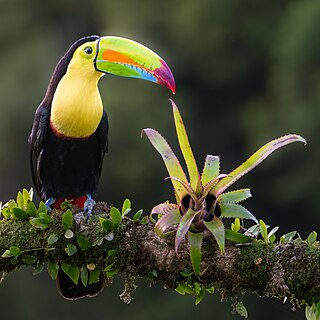
The keel-billed toucan, also known as sulfur-breasted toucan, keel toucan, or rainbow-billed toucan, is a colorful Latin American member of the toucan family. It is the national bird of Belize. The species is found in tropical jungles from southern Mexico to Ecuador. It is an omnivorous forest bird that feeds on fruits, seeds, insects, invertebrates, lizards, snakes, and small birds and their eggs.

The toco toucan is a species of bird in the toucan family Ramphastidae. It is the largest species of toucan and has a distinctive appearance, with a black body, a white throat, chest and uppertail-coverts, and red undertail-coverts. Its most conspicuous feature is its massive beak, which is yellow-orange with a black base and large spot on the tip. It is endemic to South America, where it has a wide distribution from the Guianas south to northern Argentina and Uruguay, and its range has recently been expanding southwards. Unlike other toucans, which inhabit continuous forests, toco toucans inhabit a variety of semi-open habitats at altitudes of up to 1,750 m. They are especially common in the Brazilian cerrado, gallery forests, and the wetlands of the Pantanal.

The Tucana Dwarf Galaxy is a dwarf galaxy in the constellation Tucana. It was discovered in 1990 by R.J. Lavery of Mount Stromlo Observatory. It is composed of very old stars and is very isolated from other galaxies. Its location on the opposite side of the Milky Way from other Local Group galaxies makes it an important object for study.
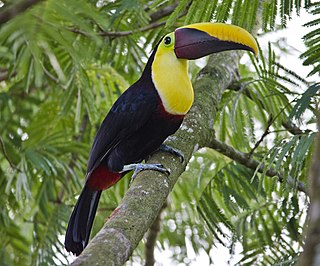
The chestnut-mandibled toucan or Swainson's toucan is a subspecies of the yellow-throated toucan which breeds from eastern Honduras to northern Colombia to western Ecuador.

The white-throated toucan is a near-passerine bird in the family Ramphastidae found in South America throughout the Amazon Basin including the adjacent Tocantins and Araguaia River drainage. It prefers tropical humid forest, but also occurs in woodland and locally in riverine forest within cerrado.

The Ramphastos genus, also known as toucans, is a genus of brightly colored, tropical birds that are found throughout Central and South America from Southern Mexico to the southern cone of the South American continent. Toucans are typically characterized by their large, colorful bills, which are used for a variety of functions such as thermoregulation, feeding, and social signaling.
A Toucan is a brightly marked tropical bird with a colorful bill.
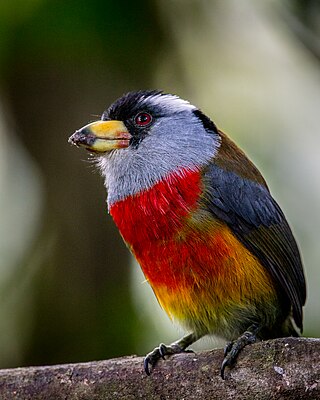
The toucan barbet is a barbet native to western Ecuador and Colombia. Along with the prong-billed barbet, it forms the family Semnornithidae, and is closely related to the toucans. It is a medium-sized barbet with a robust yellow bill. It has striking plumage, having a black head with grey throat and nape, red breast and upper belly, yellow lower belly and grey wings and tail.

The yellow-throated toucan is a Near Threatened species of bird in the family Ramphastidae, the toucans, toucanets, and aracaris. It is found from Honduras south into northern South America and beyond to Peru.

The red-breasted toucan or green-billed toucan is a bird in the family Ramphastidae, the toucans, toucanets, and aracaris. It is found in Argentina, Brazil, Bolivia and Paraguay.
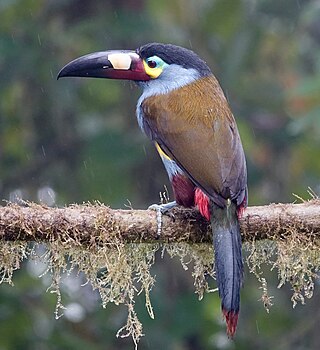
The plate-billed mountain toucan is a species of bird in the family Ramphastidae. It is native to the west slope of Ecuador and extreme southern Colombia, where it lives in the high-altitude humid mountain forests of the Andes.
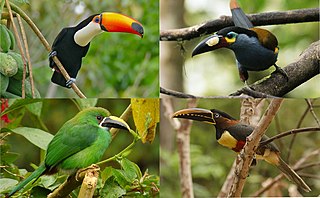
Toucans are Neotropical members of the near passerine bird family Ramphastidae. The Ramphastidae are most closely related to the American barbets. They are brightly marked and have large, often colorful bills. The family includes five genera and over 40 different species.
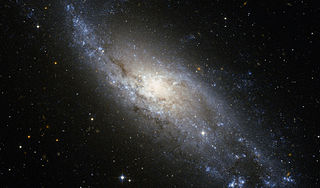
NGC 406 is a spiral galaxy quite similar to the well known Whirlpool Galaxy, located some 65 million light-years away, in the southern constellation of Tucana and discovered in 1834 by John Herschel. It is described in the New General Catalogue as "faint, very large, round, very gradually a little brighter middle". NGC 406 is about 60000 light-years across, roughly half the diameter of the Milky Way.
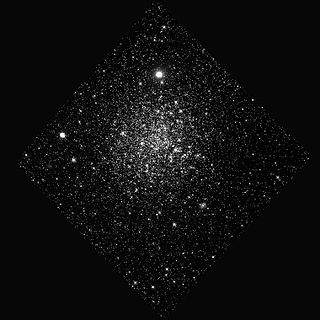
NGC 339 is a globular cluster in the constellation Tucana the Toucan. It is located both visually and physically in the Small Magellanic Cloud, being only about 10,000 ± 12,000 light years closer than the cloud. It is rather prominent, being the brightest cluster in the southern reaches of the cloud. It was discovered by John Herschel on September 18, 1835. It was observed in 2005 by the Hubble Space Telescope. Its apparent V-band magnitude is 12.12, but at this wavelength, it has 0.19 magnitudes of interstellar extinction.

NGC 299 is an open cluster of stars in the main body of the Small Magellanic Cloud – a nearby dwarf galaxy. It is located in the southern constellation of Tucana, just under 200,000 light years distant from the Sun. The cluster was discovered on August 12, 1834, by English astronomer John Herschel.


















